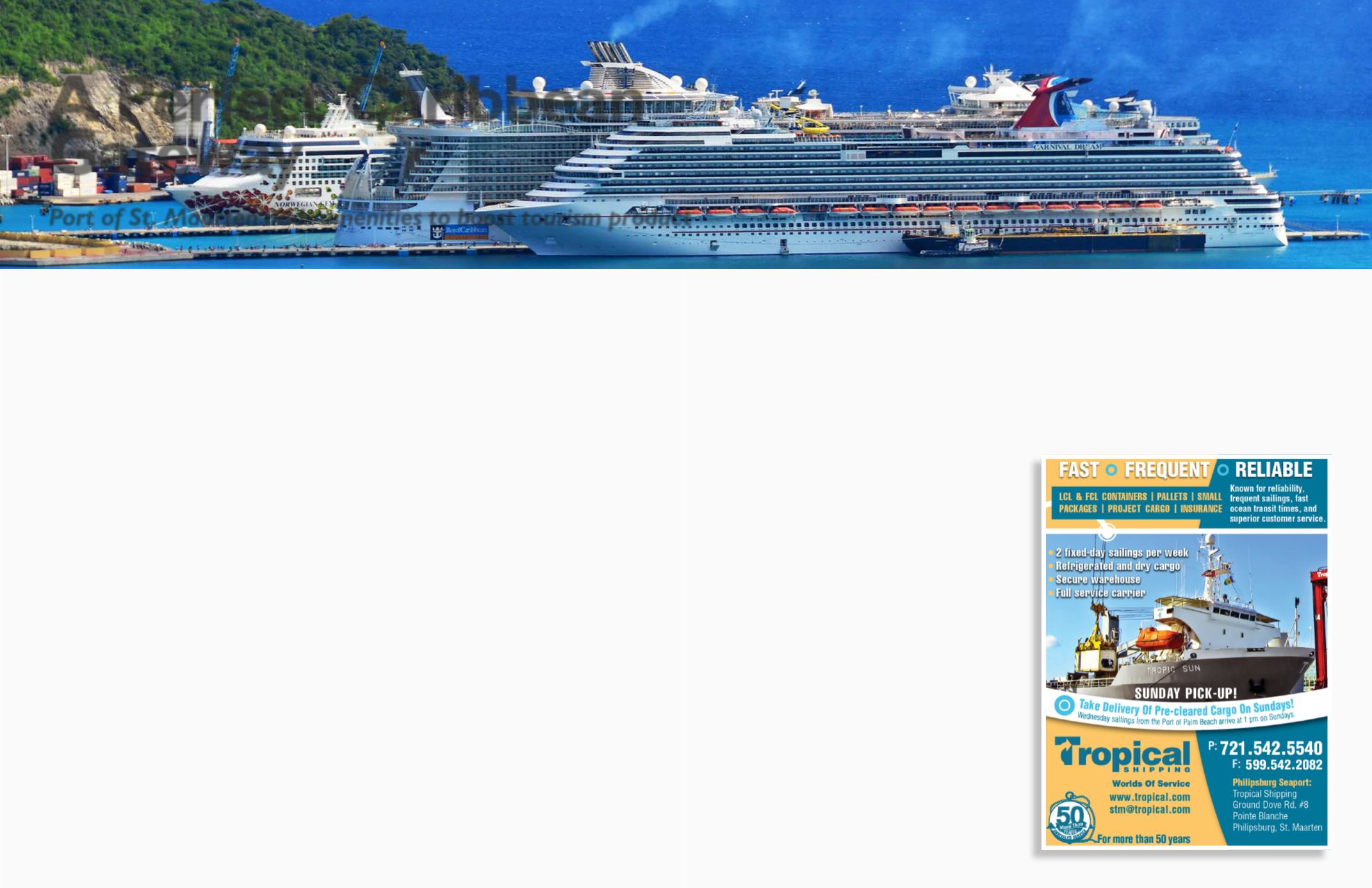
A Perfect Caribbean
Gateway
Port of St. Maarten adds amenities to boost tourism product
T
he island on which it sits is a world-recognized
cruise destination. But incoming and outgoing
cruise ships are not the only thing keeping
people busy at the Port of St. Maarten.
The port’s management went from public to private
in 1989, and, following the devastation caused by
hurricanes Luis and Marilyn in 1995, the urgency to
rebuild was renewed in the form of the Modified SMPA
1996 Layout, which eventually resulted in construction
of the modern facility.
Another development item has been the creation of
Harbour Point Village, a complex consisting of 12 shops
and 12 market stalls that’s intended for cruise visitors
who chose not to leave the boat on an organized
tour, or for those who did leave the vessel but had no
opportunity to purchase souvenirs.
The basic village concept was to duplicate old
buildings and enhance the nostalgic feel of the capital
city of Philipsburg, which was of particular importance
to differentiate the village from the island’s other high-
quality shopping centers.
No fewer than eight cruise ships arrived to the port
on a single day last December, making it the single
biggest day of the season and the only day on which
more than 22,000 passengers would be in the port
at one time. Greeting the arriving passengers was a
laundry list of activities that included a live broadcast by
a local radio station, holiday caroling and live music and
dancing.
The Carnival Dream ship arrived with 3,652 cruise
passengers, the Celebrity Reflection brought another
3,030 and was followed by the Crystal Serenity
(1,096), the Norwegian Gem (2,466), the Norwegian
Sun (2,250), the Oasis of the Seas (5,400), the Ventura
(3,100) and the Westerdam (1,848).
The previous record gathering at the port was in
2005, when nine ships and 18,000 passengers arrived.
“Cruise tourism is what makes our country tick,” said
Mark Mingo, CEO of the St. Maarten Harbour Group
of Companies. “It is a very important segment of our
economy and we have to do everything to protect it
and safeguard our visitors in order for them and the
cruise lines to continue to visit our destination.”
Going forward, the island’s top leaders have even
more in mind.
An introductory guide for foreign investors – the
St. Maarten Investors’ Guide 20/20 – aims to indicate
what the country has to offer investors and illustrate the
directions in which it is heading. A DVD was presented
as a preview of what the guide will include.
The scheduled expansion of the Panama Canal is
seen as a watershed moment for the island, which,
according to the guide, will enable St. Maarten to
expand its port operations – air and sea – to provide
sub-hub transportation services between Latin America
and Europe.
Other aims include the attraction of boat yard,
maintenance and repair interests, along with other
service providers, to enhance the stay of the island’s
visiting yacht operators.
Small renewable energy manufacturers are also
sought, as are small and medium-sized marketing,
advertising and promotional companies to promote
and distribute European and Latin American products
and services from St. Maarten to the rest of the
Caribbean and beyond.
“When you work together you are able to achieve
a lot,” said Ted Richardson, minister of tourism and
economic affairs, transport and telecommunication.
“This is a beginning. This project has to trigger interest
abroad. It shows that St. Maarten is a great country to
do business with.”
In the late 1950s, Dr. A.C. Wathey was among the
first to recognize that tourism could be a transcendent
industry on the tiny island – comprised of just 37
square miles – in the northeastern Caribbean. And
Wathey, who died in 1998, was considered the “Father
of Modern Day St. Maarten” for his efforts.
Since his pronouncements decades ago, the constant
and unprecedented growth of the industry has
resulted in tourism being the foundation for the island’s
economy. The island’s first deep-water pier at Great
Bay was labeled the Dr. A.C. Wathey Cruise Pier
when it opened in 1964, and he continued to call for
newer, larger and better harbor facilities to match the
burgeoning potential his native land possessed.
In 1980, 105,000 cruise passengers visited the island.
Nine years later that annual number had jumped more
than six times, and, by the end of 2002, the figure
reached 1 million.
But while Wathey did not live to see his urgings for
drastic facility upgrades become reality, his name now
adorns the entire complex – which is named the Dr.
A.C. Wathey Cruise & Cargo Facilities. The sprawling
harbor is also home to a similarly named cruise pier,
the Dr. A.C. Wathey Cruise Pier, along with the John
Craane Cruise Terminal and the Captain David Cargo
Quay.
The cargo quay has a length of 540 meters, docking
capacity for three general lift-on lift-off and two roll-on
roll-off vessels at a water depth of 35 feet. The facility
is serviced by two 100-ton Gottwald shore cranes and
includes a container storage area of over 3,000 TEUs
(twenty-foot equivalent units).


